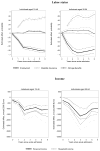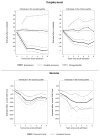Long Term and Spillover Effects of Health Shocks on Employment and Income
- PMID: 25067853
- PMCID: PMC4110210
- DOI: 10.1353/jhr.2013.0031
Long Term and Spillover Effects of Health Shocks on Employment and Income
Abstract
We use matching combined with difference-in-differences to identify the causal effects of sudden illness, represented by acute hospitalizations, on employment and income up to six years after the health shock using linked Dutch hospital and tax register data. An acute hospital admission lowers the employment probability by seven percentage points and results in a five percent loss of personal income two years after the shock. There is no subsequent recovery in either employment or income. There are large spillover effects: household income falls by 50 percent more than the income of the disabled person.
Figures









References
-
- Aarts Leo, Burkhauser Richard V, de Jong Philip R. Curing the Dutch Disease: an International Perspective on Disability Policy Reform. Aldershot, U.K: Avebury; 1996.
-
- Apps Patricia F, Rees Ray. Collective Labor Supply and Household Production. Journal of Political Economy. 1997;105(1):178–190.
-
- Banks James. Economic Capabilities, Choices and Outcomes at Older Ages. Fiscal Studies. 2006;27(3):281–311.
-
- Becker Sascha O, Ichino Andrea. Estimation of Average Treatment Effects Based on Propensity Scores. The Stata Journal. 2002;2(4):358–377.
-
- Berger Mark C. Labour Supply and Spouse’s Health: the Effects of Illness, Disability and Mortality. Social Science Quarterly. 1983;64(3):494–509.
Grants and funding
LinkOut - more resources
Full Text Sources
Other Literature Sources
